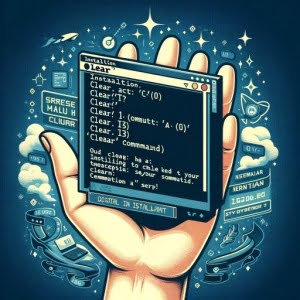Installing and Using ‘Clear’ Command | Linux Guide

Are you looking to install the ‘clear’ command on your Linux system but aren’t sure where to start? Many Linux users, particularly beginners, might find the task intimidating. Yet, the ‘clear’ command is a powerful tool to tidy up your terminal; it’s a utility worth mastering.
Additionally, the ‘clear’ command is readily available on most package management systems, making it a straightforward process once you know-how.
In this tutorial, we will guide you on how to install the ‘clear’ command on your Linux system. We will show you methods for both APT and YUM-based distributions, delve into compiling the ‘clear’ command from source, installing a specific version, and finally, how to use the ‘clear’ command and ensure it’s installed correctly.
So, let’s dive in and begin installing the ‘clear’ command on your Linux system!
TL;DR: How Do I Install and Use the ‘Clear’ Command in Linux?
In most Linux distributions, the
'clear'command comes pre-installed, you can verify this with the commandwhich clear. If for some reason ‘clear’ is not installed, you can add it via the ncurses package with,sudo apt-get install ncurses-binorsudo yum install ncurses. To use it, simply typeclearin your terminal and press enter.
echo 'Hello, World!'
clear
# Output:
# [Your terminal screen will be cleared]
This is just a basic way to use the ‘clear’ command in Linux, but there’s much more to learn about installing and using ‘clear’. Continue reading for more detailed information and advanced usage scenarios.
Table of Contents
- Understanding the ‘Clear’ Command in Linux
- Installing ‘Clear’ Command from Source Code
- Installing Different Versions of ‘Clear’ Command
- Using ‘Clear’ Command and Verifying Installation
- Exploring Alternatives to ‘Clear’ Command in Linux
- Troubleshooting Common Issues with ‘Clear’ Command
- Unraveling Terminal Operations in Linux
- The Relevance of Terminal Management in System Administration and Scripting
- Wrapping Up: Installing the ‘Clear’ Command in Linux
Understanding the ‘Clear’ Command in Linux
The ‘clear’ command in Linux is a straightforward utility that helps to clean up the clutter in your terminal. When you’re working in a terminal, the commands you’ve executed and their outputs can quickly pile up, making the terminal look messy and difficult to read. Here’s where the ‘clear’ command comes in. By typing ‘clear’ and pressing enter, you can wipe your terminal clean, giving you a fresh start.
Now, let’s look at how to install the ‘clear’ command in Linux.
Installing ‘Clear’ Command with apt
If you’re using a Debian-based distribution like Ubuntu, you’ll use the apt package manager to install the ‘clear’ command. However, in most cases, the ‘clear’ command comes pre-installed. You can check if it’s already installed by typing the command in your terminal.
clear
# Output:
# [Your terminal screen will be cleared]
If the ‘clear’ command isn’t installed, you can install it using the following command:
sudo apt-get install ncurses-bin
# Output:
# [Lines showing the installation process]
The ‘clear’ command is part of the ncurses-bin package in Debian-based distributions, so installing this package will give you access to the ‘clear’ command.
Installing ‘Clear’ Command with yum
For distributions that use the yum package manager, like CentOS, the process is similar. Again, the ‘clear’ command is usually pre-installed, but if it’s not, you can install it with the following command:
sudo yum install ncurses
# Output:
# [Lines showing the installation process]
Once you’ve installed the ‘clear’ command, you can use it to clear your terminal screen at any time. Just type ‘clear’ and press enter. This command is particularly useful when you’re dealing with a cluttered terminal and need a fresh start.
Installing ‘Clear’ Command from Source Code
In some cases, you might want to install the ‘clear’ command from its source code. This could be due to a variety of reasons, such as needing a specific version that’s not available in your distribution’s package manager, or wanting to modify the source code for your specific needs.
Here’s how you can compile and install the ‘clear’ command from source:
git clone https://github.com/ncurses/ncurses.git
cd ncurses
./configure
make
sudo make install
# Output:
# [Lines showing the compilation and installation process]
Installing Different Versions of ‘Clear’ Command
From Source
To install a specific version of the ‘clear’ command from source, you’ll need to checkout the specific version tag before compiling:
git clone https://github.com/ncurses/ncurses.git
cd ncurses
git checkout tags/v6.1
./configure
make
sudo make install
# Output:
# [Lines showing the checkout, compilation, and installation process]
Using Package Managers
apt
For Debian-based distributions, you can specify the version of the package you want to install with apt:
sudo apt-get install ncurses-bin=6.1-1ubuntu1
# Output:
# [Lines showing the installation process]
yum
With yum, you can install a specific version of a package using the following command:
sudo yum install ncurses-6.1-1
# Output:
# [Lines showing the installation process]
Version Comparison
Different versions of the ‘clear’ command might have different features or bug fixes. Here’s a brief comparison of some of the recent versions:
| Version | Key Changes |
|---|---|
| 6.1 | Added support for new terminal types |
| 6.0 | Fixed a bug with clearing the terminal buffer |
| 5.9 | Improved compatibility with older Linux distributions |
Using ‘Clear’ Command and Verifying Installation
How to Use ‘Clear’ Command
Once installed, you can use the ‘clear’ command to clear your terminal screen. For example, you can use it to clear the screen after running a command that produces a lot of output:
echo 'This is a lot of output'
clear
# Output:
# [Your terminal screen will be cleared]
Verifying ‘Clear’ Command Installation
To verify that the ‘clear’ command has been installed correctly, you can use the ‘which’ command. This command will show you the path to the binary of the ‘clear’ command:
which clear
# Output:
# /usr/bin/clear
If the ‘clear’ command is installed correctly, this command will output the path to the ‘clear’ command. If it’s not installed, this command won’t output anything.
Exploring Alternatives to ‘Clear’ Command in Linux
While the ‘clear’ command is an excellent tool for decluttering your terminal, it’s not the only way to achieve a clean slate. There are alternative methods to clear the terminal in Linux, one of which is the ‘reset’ command.
The ‘Reset’ Command
The ‘reset’ command is a more powerful alternative to ‘clear’. It not only clears the terminal screen but also resets the terminal’s state, including any changes made to the terminal’s settings.
Here’s how you can use the ‘reset’ command:
echo 'This is some output'
reset
# Output:
# [Your terminal screen will be cleared and reset]
Advantages and Disadvantages
The ‘reset’ command is more thorough than ‘clear’, which can be an advantage if your terminal’s settings have been changed and you want to reset them to their defaults. However, this can also be a disadvantage if you’ve made changes to your terminal’s settings that you want to keep.
Recommendations
If you’re just looking to clear your terminal screen, the ‘clear’ command is a quick and easy solution. However, if you need to reset your terminal’s settings as well, the ‘reset’ command is a powerful tool that can help you get back to a default state.
As always, the best tool for the job depends on your specific needs and circumstances. Understanding the options available to you can help you make the best choice for your situation.
Troubleshooting Common Issues with ‘Clear’ Command
While the ‘clear’ command is generally straightforward, there might be times when you encounter issues. Here are some common problems and their solutions.
‘Clear’ Command Not Found
If you get an error message saying ‘clear: command not found’, it means the ‘clear’ command is not installed on your system. You can install it using your package manager, as described in the earlier sections of this guide.
clear
# Output:
# clear: command not found
Terminal Not Clearing Completely
Sometimes, you might find that the ‘clear’ command doesn’t clear the terminal completely. This could be due to a large command history. In such cases, you can use the ‘reset’ command to clear the terminal and reset its state.
echo 'This is some output'
reset
# Output:
# [Your terminal screen will be cleared and reset]
‘Clear’ Command Doesn’t Work in Scripts
If you’re writing a script and find that the ‘clear’ command doesn’t work, it might be because the script is running in a non-interactive shell. In this case, you can use the ‘tput clear’ command instead, which should work in both interactive and non-interactive shells.
#!/bin/bash
echo 'This is some output'
tput clear
# Output:
# [Your terminal screen will be cleared]
Remember, the ‘clear’ command is a powerful tool for managing your terminal’s clutter. Understanding its potential issues and how to troubleshoot them can help you use the ‘clear’ command more effectively.
Unraveling Terminal Operations in Linux
Before we delve further into the ‘clear’ command, it’s essential to understand the fundamental operations of the Linux terminal. The terminal, also known as the shell, is a command-line interface that allows you to interact with your Linux system. It’s a powerful tool that can perform a wide range of tasks, from managing files and directories to monitoring system performance and running scripts.
The Importance of Terminal Management in Linux
Managing your terminal effectively is crucial for maintaining a productive and efficient workflow. A cluttered terminal can slow down your work and make it harder to keep track of what you’re doing. That’s where commands like ‘clear’ come in handy.
The ‘clear’ command is part of a suite of tools designed to help manage your terminal. These tools can clear your terminal screen, reset your terminal’s state, and more. Understanding these tools and how to use them can greatly enhance your command-line experience.
Understanding Linux Terminals
Linux terminals operate using a shell, which is a program that takes in commands and passes them to the operating system to execute. There are many different shells available for Linux, but the most common one is the Bourne Again Shell (BASH).
Here’s an example of a simple BASH command:
echo 'Hello, Linux!'
# Output:
# Hello, Linux!
In this example, ‘echo’ is a command that tells the shell to output whatever follows it. In this case, it outputs ‘Hello, Linux!’.
The ‘clear’ command is another example of a BASH command. It tells the shell to clear the terminal screen, giving you a clean slate to work with.
echo 'This is some output'
clear
# Output:
# [Your terminal screen will be cleared]
In this example, the ‘echo’ command outputs ‘This is some output’, and then the ‘clear’ command clears the terminal screen. Understanding these basic operations is the first step towards mastering terminal management in Linux.
The Relevance of Terminal Management in System Administration and Scripting
Mastering terminal management is vital for anyone working with Linux, especially system administrators and script developers. The ‘clear’ command is just one of the many tools you have at your disposal for managing terminal clutter. Its simplicity and efficiency make it a go-to solution for many users.
In system administration, keeping a clean and organized terminal is crucial. It helps in diagnosing system issues, running administrative commands, and monitoring system performance. Similarly, for script developers, a well-managed terminal can make coding, debugging, and testing scripts much easier.
Terminal Multiplexers: The Next Step in Terminal Management
Once you’ve mastered basic terminal commands like ‘clear’, you might want to explore more advanced tools like terminal multiplexers. Terminal multiplexers, such as tmux or screen, allow you to create multiple terminal sessions within a single terminal window. This can be particularly helpful when working on complex tasks that require you to run multiple commands simultaneously or keep track of multiple command outputs.
Here’s a simple example of how to use tmux:
tmux new -s mysession
# Output:
# [A new tmux session named 'mysession' is created]
In this example, the ‘tmux new -s mysession’ command creates a new tmux session named ‘mysession’. You can then run commands in this session, switch to other sessions, or even detach from the session and return to it later.
Further Resources for Mastering Linux Terminal Management
To delve deeper into terminal management in Linux, here are some resources you might find useful:
- The Linux Command Line: A comprehensive guide to the Linux command line, covering everything from basic commands to shell scripting.
GNU Screen Manual: The official manual for GNU Screen, a highly configurable terminal multiplexer.
Tmux: A Simple Start: A beginner-friendly introduction to tmux, another powerful terminal multiplexer.
Wrapping Up: Installing the ‘Clear’ Command in Linux
In this comprehensive guide, we’ve delved into the world of the ‘clear’ command in Linux, a simple yet powerful tool for managing terminal clutter. We’ve explored how to install and use the ‘clear’ command, tackled common issues, and even ventured into alternative methods of clearing the terminal.
We began with the basics, discussing how to install the ‘clear’ command using package managers like apt and yum. We then moved on to more advanced topics, such as compiling the ‘clear’ command from source and installing specific versions of the command.
Along the way, we addressed common issues that you might encounter when using the ‘clear’ command and provided solutions. We also introduced alternative methods for clearing the terminal, such as the ‘reset’ command, and discussed their pros and cons.
Here’s a quick comparison of the methods we’ve discussed:
| Method | Pros | Cons |
|---|---|---|
| ‘clear’ command | Quick and easy to use | May not clear terminal completely in some cases |
| ‘reset’ command | Clears terminal and resets its state | Might reset desired terminal settings |
Whether you’re a beginner just starting out with Linux or an experienced user looking to improve your terminal management skills, we hope this guide has given you a deeper understanding of the ‘clear’ command and its alternatives.
With the ‘clear’ command and its alternatives at your disposal, you’re well-equipped to manage terminal clutter effectively. Happy coding!


